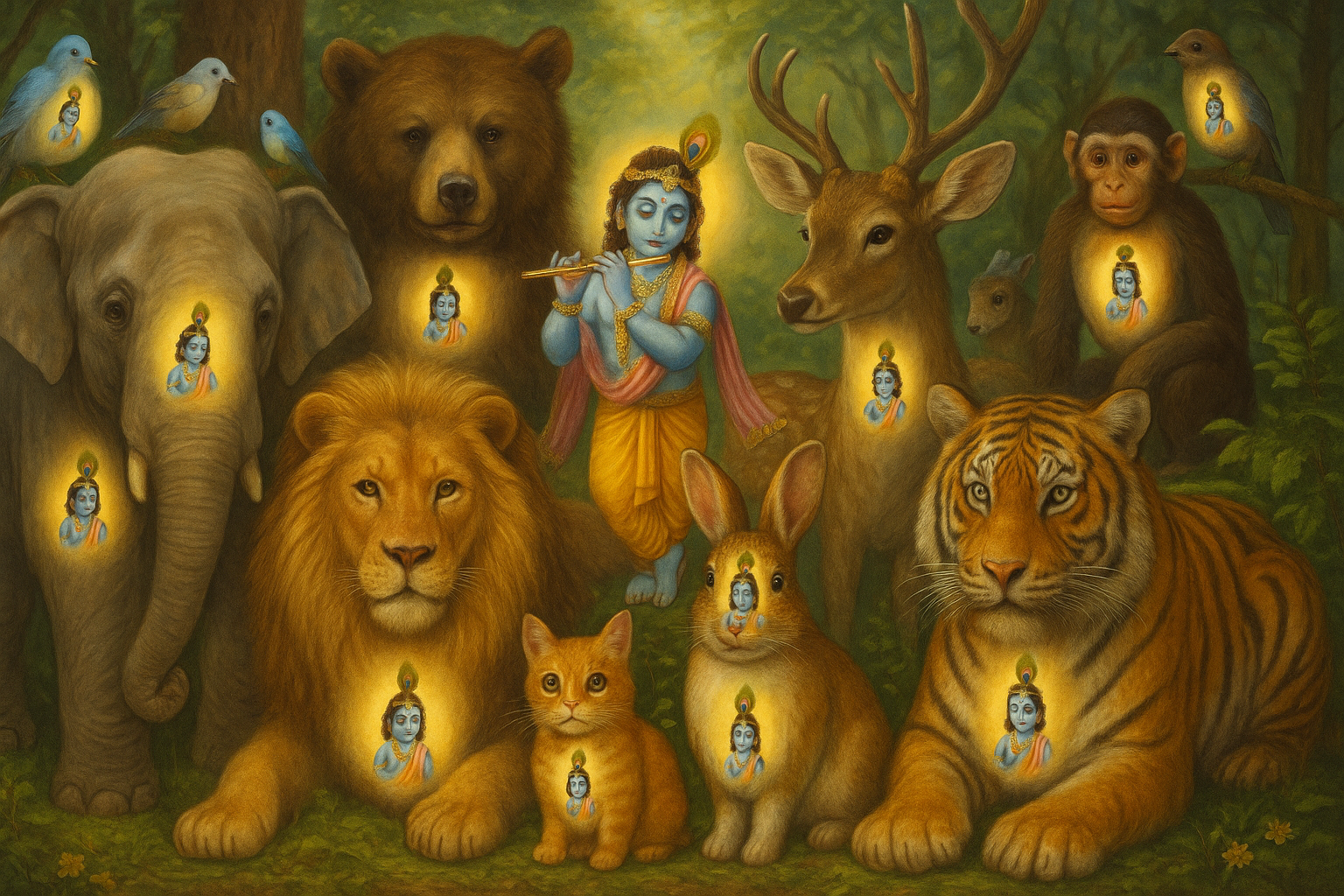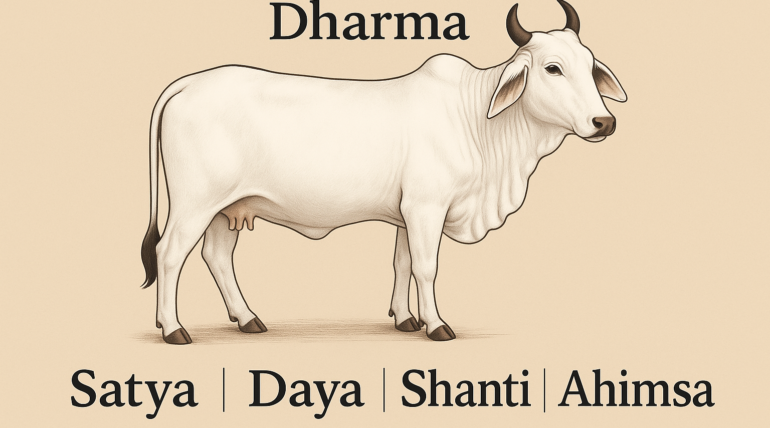Ananya Bhakti: The Unwavering Devotion Beyond Duality
So far, we have explored divine incarnations, their purposes—especially the incarnation of Krishna—and the foundational philosophy behind them. Krishna is the embodiment of compassion. His very nature is to attract and uplift all living beings. The Supreme descends not out of need but solely for the upliftment of souls. As Krishna says in the Bhagavad Gita:
“Nānavāptam avāptavyam — Varta eva cha karmaṇi”
“I have nothing to gain, yet I continue to act.”
And what is this action? It is the compassionate effort to elevate beings toward liberation.
This descent is understood in two modes: pratiloma (oppositional method) and anuloma (harmonious method). The pratiloma method suppresses evil, while the anuloma bestows grace upon the virtuous. And what does this grace entail? It is the teaching of the path to liberation. That path is Bhakti—unwavering devotion. It is the same path taught by Sage Shuka to King Parikshit in his final days.
What is Bhakti?
The word Bhakti originates from bhajana (worship) and is related to vibhajana (division or separation). The term vibhakta means one who is separated. We are all, in truth, separated from our divine source—so much so that we no longer know when or how the separation occurred. Because of this separation, we are drowning in the ocean of worldly existence
To escape this ocean—in this or any future life—we must turn toward that divine source through bhajana, which makes us bhaktas (devotees). Bhakti means to hold onto the Supreme without letting go, like a worm contemplating the wasp until it becomes one itself (bhramara-keeta nyaya). This is affirmed in the Upanishads:
“Brahmaveda brahmaiva bhavati”
“The knower of Brahman becomes Brahman.”
This transformation isn’t into something new, but rather a reawakening to our original nature. Just as one forgets their name and then remembers it again, our real identity as the Self remains intact, waiting to be realized. Realizing this forgotten truth is the essence of Bhakti.
Bhakti as a Bridge
Bhakti serves as the bridge between the Bhagavata (devotee) and Bhagavan (God). It links both ends, uniting the divine and the human in a single current of love and awareness.
But this devotion has four distinct stages:
- Holding on without knowing.
- Holding on with incomplete knowledge.
- Knowing, but not holding on firmly.
- Knowing and holding on firmly.
These correspond respectively to:
- Karma Yoga – action without true understanding
- Bhakti Yoga – emotional devotion with partial knowledge
- Jnana Yoga – correct understanding without firm commitment
- Ananya Bhakti or Jnana Nishtha – steadfast knowledge with unwavering devotion
In the first three, either knowledge or firmness is lacking. Only in the fourth stage does knowledge mature into unwavering commitment—this is Ananya Bhakti.
The Meaning of “Ananya”
The word Ananya means “not-other.” It is the state where no second entity is perceived as distinct from oneself. Anyatva (otherness) refers to perceiving the world or even God as separate from the Self. But in Ananya Bhakti, even the idea of a separate God disappears.
The Upanishads declare:
“Dvitīyād vai bhayam bhavati”
“Where there is duality, there is fear.”
Thus, Ananya Bhakti is freedom from all duality, the undivided awareness where God, world, and Self merge into one consciousness.
Scriptural Support
This understanding is not unique to the Bhagavatam. The Vishnu Purana echoes it:
“Viṣṇos sarvam idaṁ jagat, draṣṭavyaṁ ātmavat tasmād abhedena vicakṣaṇaḥ”
“This entire universe is Vishnu and must be seen as non-different from the Self.”
Bhakti and Jnana are not two paths—they are two names for one realization: Jnana Nishtha (firm knowledge) expressed through devotion.
Liberation Through Ananya Bhakti
True moksha (liberation) comes only when there is no sense of otherness. Other spiritual paths—though beneficial—retain subtle separations between the Self and the Divine.
The Bhagavatam thus declares that Ananya Bhakti alone is the direct path to moksha. Even Saguna Bhakti (devotion with form and attributes) is preparatory and limited by duality. Only when that devotion matures into the non-dual state of Ananya Bhakti does liberation dawn.
How Does Knowledge Become Firm?
It’s not enough to intellectually understand that “I am Brahman.” That knowledge must become an unbroken awareness. The Bhagavatam says this:
“mokṣa sādhana sāmagrī bhaktiḥ eva garīyasī”
“Among all means to liberation, Bhakti is the greatest.”
Why? Because it transforms knowledge into realization.
Because Sva-svarūpa-anusandhānam bhaktiḥ—Bhakti is the uninterrupted contemplation of one’s true Self.
When this Self-awareness pervades every perception, every experience, and every thought, it becomes Ananya Bhakti—the culmination of knowledge.
This is only the first segment of your vast exposition. I recommend breaking this up into a thematic booklet (e.g., “Ananya Bhakti – The Path Beyond All Duality”) with 6–10 titled sections like:
- Why God Incarnates: Compassion, Not Need
- Bhakti: Holding the Divine with One-Pointed Love
- From Karma to Jnana: The Four Types of Devotional Grip
- Ananya Bhakti: The State Beyond All Otherness
- The Bridge Between Devotion and Knowledge
- The Progression: Saguna to Nirguna Bhakti
- The Role of Fear, Hatred, Love, and Relationship in Bhakti
- Why Even Enemies of God Attain Him
- The Ninefold Path of Devotion and Its Inner Meaning
- The Final Realization: When Bhakti and Jnana Become One
Ananya Bhakti – The Path Beyond All Duality
1. Why God Incarnates: Compassion, Not Need
Divine incarnations occur not because God has any desire or necessity, but solely out of compassion. Krishna, the embodiment of love and grace, affirms in the Bhagavad Gita: “Nānavāptam avāptavyam — Varta eva cha karmaṇi” — “I have nothing to attain, yet I engage in action.” That action is the upliftment of souls. He descends for the liberation of those seeking truth, employing both oppositional (pratiloma) and harmonious (anuloma) methods: destroying evil and bestowing grace.
2. Bhakti: Holding the Divine with One-Pointed Love
Bhakti arises from the word bhajana (worship), which is related to vibhajana (separation). Being separated from the Divine for lifetimes, we remain unaware of our own origin. Bhakti is the means to bridge that separation. It is not a passive emotion but an active holding on — like the insect that transforms into a wasp by constantly contemplating it (bhramara-keeta nyaya). This is echoed in the Upanishadic statement: “Brahmaveda brahmaiva bhavati” — “The knower of Brahman becomes Brahman.”
3. From Karma to Jnana: The Four Types of Devotional Grip
Devotion progresses through four stages:
- Holding on without knowledge — Karma Yoga
- Holding on with incomplete knowledge — Bhakti Yoga
- Knowing without firmness — Jnana Yoga
- Knowing and holding on firmly — Purna Jnana or Ananya Bhakti
In the fourth, knowledge becomes unwavering — this is Jnana Nishtha or Ananya Bhakti.
4. Ananya Bhakti: The State Beyond All Otherness
Ananya means “not-other.” Duality is the root of fear (“Dvitīyād vai bhayam bhavati”). Ananya Bhakti is the unwavering devotion in which no separation exists between the Self, the world, and God. All are realized as one reality — the Self.
5. The Bridge Between Devotion and Knowledge
Bhakti is not separate from knowledge. In its mature state, it is Jnana itself. Scriptures like the Vishnu Purana affirm: “Viṣṇos sarvam idaṁ jagat, draṣṭavyaṁ ātmavat tasmād abhedena vicakṣaṇaḥ.”
When Bhakti becomes unshakable Self-awareness, it is no longer an emotion but a constant realization — Ananya Bhakti.
6. The Progression: Saguna to Nirguna Bhakti
All devotion begins with Saguna Bhakti (worship with form and attributes). But this is preparatory. When the devotee realizes that the Divine and Self are one, and that knowledge becomes stable, it becomes Nirguna Bhakti — devotion free of attributes. This is Ananya Bhakti.
7. The Role of Fear, Hatred, Love, and Relationship in Bhakti
The Bhagavatam illustrates various paths of Bhakti:
- Gopikas: devotion through desire (kama)
- Kamsa: devotion through fear (bhaya)
- Shishupala: devotion through hatred (vaira)
- Pandavas: devotion through love and relationship (prema, sambandha)
- Narada: pure Ananya Bhakti (Nirguna)
Even enemies like Kamsa and Shishupala attained God due to intense contemplation. But only Narada’s devotion is untainted by duality.
8. The Ninefold Path of Devotion and Its Inner Meaning
Prahlada defines the Navavidha Bhakti (ninefold devotion):
- Shravanam (hearing)
- Kirtanam (chanting)
- Smaranam (remembering)
- Pāda-sevanam (serving)
- Archanam (worship)
- Vandanam (salutation)
- Dasyam (servitude)
- Sakhyam (friendship)
- Atma-nivedanam (self-surrender)
These progress from action to surrender. When surrender ripens into knowledge, and knowledge remains unbroken, it becomes Ananya Bhakti.
9. Karma, Bhakti, and Jnana: A Unified Path
Karma Yoga purifies the mind, leading to Saguna Bhakti. Saguna Bhakti matures into Jnana. Jnana, when stabilized, transforms into Ananya Bhakti. Thus, the entire spiritual path is a continuum leading to the supreme state.
As the Bhagavatam declares:
“mokṣa sādhana sāmagrī bhaktiḥ eva garīyasī” — among all means to liberation, Bhakti is supreme.
10. Conclusion: The Supreme Realization
Ananya Bhakti is not merely a method of worship. It is the final realization where all dualities dissolve. The devotee no longer sees God as separate, nor the world as other. Everything is perceived as the Self. This is the heart of Advaita Vedanta — and the soul of the Bhagavata Dharma.
In this vision, knowledge flows as devotion, and devotion shines as knowledge. This union is Ananya Bhakti — the pathless path, the devotion that transcends devotion, the knowledge that surpasses knowledge, and the only means to true liberation.



